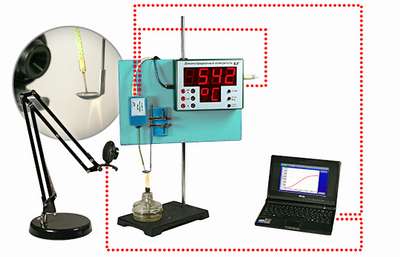
The term "digital lab" (DL) has been firmly entrenched in a wide teachers’ everyday life. Introduced a new version of the standard second-generation finally legalize the presence of this product in the education market. Our company "School World" has a rich history of creating computer applications for schools and for universities, so the description of a new digital lab we carry out on the basis of comparison with our old system, a well-known under the brand name "L-micro". Also present in some regions there are wide digital lab "Archimedes" (developed by Israeli firm "Fourier Systems") and the Laboratory of AFS (American company "Vernier"). Each of them has its advantages and features of the application, as described in the literature.
Our experience on the use of sensor systems has shown that the efficiency of their application depends largely on the ease of use and, consequently, the degree of elaboration of methodologies for experimentation, which includes both equipment and methodology and software support. Our new digital laboratory is fully took into account all the many years of experience in the real world of educational institutions of our previous decisions.
Digital Lab "Nauchnye razvlechenya" (Scientific fun) fully justifies the term as a digital detector, working directly with the computer without any additional adapters, made possible by recent advances of microprocessor technology. Significant difference from similar decisions - it is an opportunity not only to receive data from the sensor in a digital form, but also manage the work of the sensor, selecting the optimum mode of its operation. This significantly extends the capabilities of the experimenter, and lowers the price solution (comparative table).
Given the new realities when purchasing equipment can be carried out by each individual institution, the question of functionality and price becomes a key decision. To solve the real problems of teaching should be considered use of digital labs in the context of the implementation of appropriate educational standards specified allowable time intervals (baseline – 2 hours, profile – 5 hours). We offer not only an extensive list of sensors and accessories, but specific solutions that are optimized for the price and solve problems.
Demonstration module of digital laboratory NR is built on already well-established pattern, where each theme is devoted to a set that includes sensors along with special equipment, guidance on carrying out certain work on a pre-prepared script, the software for the demonstration experiment. In this case the interface of the program is designed to be able to work with the interactive whiteboard. Particular attention is paid to the possibility of using a web camera to visualize the experiment taking place on the table and simultaneously recording the measurements. The program allows you to record not only the sensors, but also the geometric parameters of the experiment.
The demo unit includes a base level experiments that illustrate basic concepts in mechanics, thermal phenomena, electrical and electromagnetic phenomena, quantum and atomic physics.
The demonstration module-level profile includes a base and significantly enhanced by additional sets, covering topics such as wave phenomena, sound waves, gas laws, microwave radiation, etc.